An article for water distribution providers
Have you had a situation where providing potable water was critical?
Maybe the only way possible was thru a lay-flat hose. Many water distributors go thru this dilemma. This can happen via water main breaks, planned outages, pipe rehabilitation, or some contractor who thought the water main was 5 feet in the other direction.
As a water provider, you must do your due diligence on providing the safest and efficient method of delivery to your customers.
California Regulation On Water Distribution
In the state of California, it is suggested to use an “NSF-61 rated lay-flat hose for drinking water, due to its high-quality material and rigorous tests.”
According to the California Code of Regulations, “No equipment used in the generation process shall be in contact with a drinking water, or a chemical to be applied to drinking water, after March 9, 2008, unless the equipment has been tested and certified as meeting the specifications of NSF” (Title 22, Section 64591.CA Code of Regulations)
Hose For Water Distribution
It is important that you use the right lay flat hose for water distribution. As noted above, California requires you to use an NSF-61 potable hose for drinking water.
Check the requirements within your own state’s guidelines before making your purchase.
Fittings and Couplings
Furthermore, you must ensure your fittings and couplings are rated for water. Led free brass is usually available but on the expensive side. Plastic is usually the way to go, but they only go up to 2”. If you have a bigger diameter you need, you will have to go with aluminum fittings and couplings.
Most aluminum fittings start at 4” in the United States, you can get a 3” NSF hose, but you will be hard-pressed to find aluminum fittings in 3” that connect to NSF hose other than fire hydrant fittings. Typically, 4” 6” 8”10” 12” are the larger sizes that aluminum fittings have the capability for connecting to NSF hose via Victaulic couplings and fittings.

